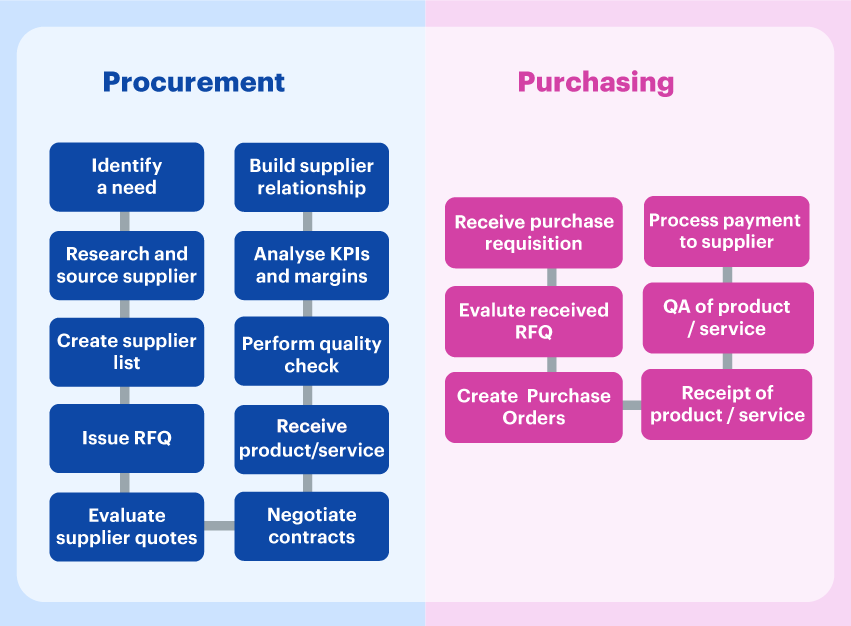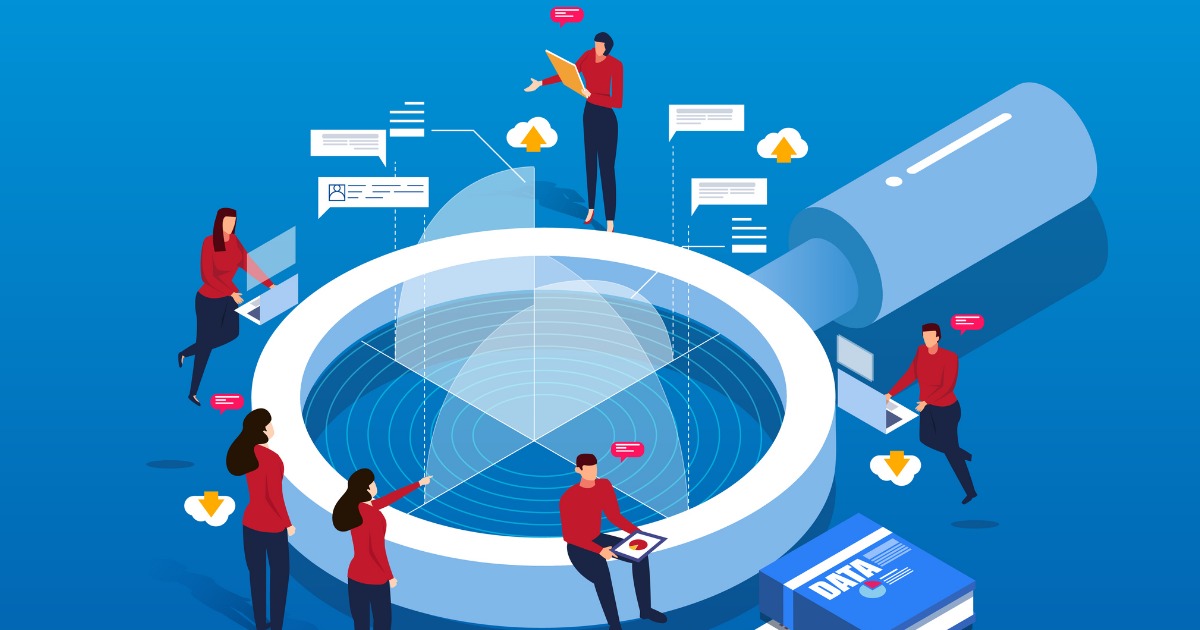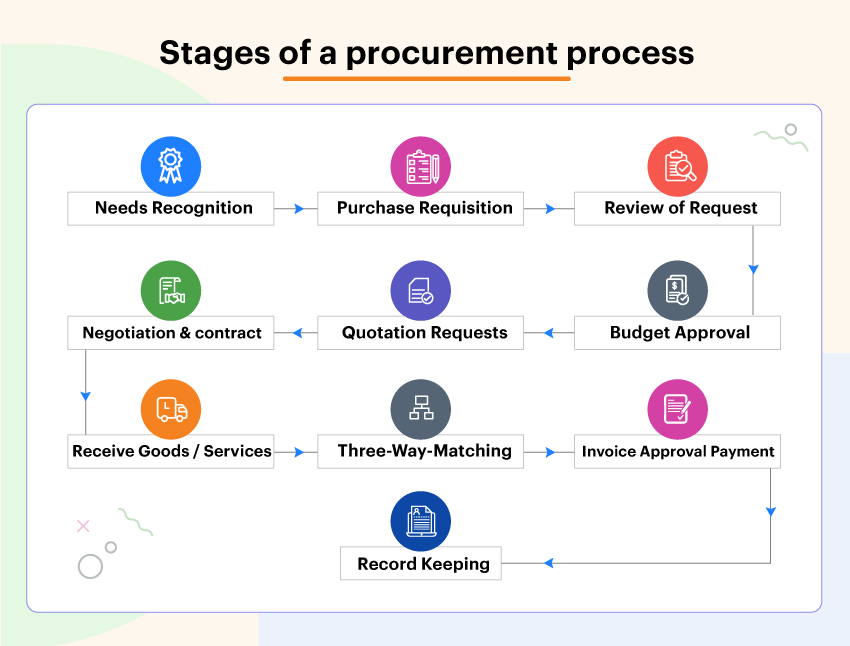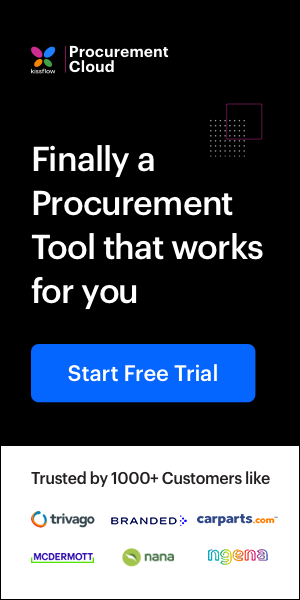On a surface level, procurement is all about acquiring the supplies an organization needs to function from day-to-day. Going into details, you start bringing in all the supporting factors that make procurement work.
Invoice processing, vendor management, fraud prevention, payments processing, quality control, etc.
Beyond the surface, it’s a bit more complicated than that.
Procurement is divided neatly into two niches—direct and indirect. And while both are essential to the functioning of every business, it’s important to understand their place so you can prioritize and give each the emphasis they both need. This way, you’ll be able to build excellent supplier relationships, manage procurement efficiently, and ensure a steady flow of the inputs you need to keep your company running.
What is direct procurement?
Direct procurement is the process of acquiring the products, supplies, goods and services you need for your core business activity.
Direct procurement, in essence, is about acquiring those essential products and services that make their way right to your end customers with some processing.
It deals with the inputs that form the backbone of what your organization offers.
Some examples of direct procurement include:
- a baker buying the flour for making bread
- a construction company making an order for the cement and blocks for an ongoing project
- a fabric factory ordering textiles and cloth materials for processing and sewing down the line
Note: Direct procurement features mostly in physical manufacturing industries where direct raw materials are processed into physical products.
What is indirect procurement?
Indirect procurement also known as indirect spend, deals with acquiring products and services that support a business’s operations, albeit in a non-essential role. These indirect supplies include office supplies & stationery, decorations, etc.
Indirect supplies are, in their own way, still essential to your organization. But they don’t exert any direct input into the finished products and services you deliver to your customers.
Rather, they play a supporting role to ensure that the process of turning direct supplies into finished goods goes smoothly.
Some example of indirect supplies includes:
- SaaS subscriptions, e.g. Slack, Asana, Kissflow
- employee development resources, e.g. books
- office decorations,
- office equipment such as laptops & personal computers.
Indirect supplies are more pronounced in digital fields where there are no tangible goods, but mostly services delivered to customers.
Differences between direct and indirect procurement
The key difference between direct and indirect procurement is the function they address. While direct procurement focuses on securing the core supplies that are processed and delivered to your customers,whereas indirect procurement deals with the supply of spontaneous goods.
The different functions of both direct and indirect procurement mean that there are differences in how both operate. As a result, you need to slightly tweak your approach to both branches to get them right.
Emphasis on customer-vendor relationship
Direct procurement deals with acquiring the supplies that constitute the base of what your business offers your customers. That is to say, without the products of direct procurement, nothing works.
To ensure you can guarantee a steady supply chain, it’s in your best interest to build long-term, sustainable relationships with your suppliers.
This is where vendor management, contracts, minimum order quantities, etc., come in.
Under direct procurement, there’s a need to build a reliable customer-vendor relationship that can stay resilient when you need it, providing security for both sides. A great way to improve the buyer-vendor relationship is to create a strategic sourcing plan. Here's a guide to do it.
Indirect procurement, on the other hand, deals with non-essential supplies that assist your business operations but don’t constitute your core operation. Consequently, indirect procurement doesn’t get the emphasis direct procurement gets.
Rather, your organization can get a shortlist of vendors and use the services whenever it’s called for. Even if they don’t measure up when called for, you have a lot of alternatives and can even delay the supplies you’re looking to acquire.
Direct procurement, given its importance, leads to deeper vendor relationships you can count on, while indirect vendors can be managed with little if any effort to retain their services for the long term.
Indirect supplies are too numerous and often relatively insignificant to compensate for the cost of getting locked into contracts, etc.
Planned vs. spontaneous spend
Direct procurement manages the core supplies your business needs to run day-to-day, and as a result, needs emphasis to ensure resilience. The essential inputs you need to keep running operations need to be planned and budgeted well in advance to avoid disruptions to your supply chain.
For indirect supplies, on the other hand, it can be hard getting exact figures to estimate demand and as such, there’s little planning or budgeting for indirect procurement. Indirect supplies are often procurement spontaneously as the need arises, unlike direct supplies.
Inventory management
Managing inventory deals with how to acquire, store, and plan for inventory. Most often, this is exclusive to direct supplies, given the risk and reward associated with managing the supply chain for your direct inputs.
For indirect inputs, there’s no long-term strategy for managing them since they’re often not planned for.
As result, it can be hard managing inventory, ensuring quality, and keeping suppliers compliant to your organization’s specifications and quality standards.
Use Kissflow to Supercharge Your Procurement
Kissflow Procurement Cloud takes care of indirect spend end-to-end. It is designed to streamline procurement for organizations of all sizes, with features such as:
- Product catalogs for easy ordering
- Vendor management, from sourcing suppliers to payments
- Multiple payment options that accommodate different suppliers
- Advanced security protocols that protect your data
- Customizable workflow and processes that streamline operations
- A simple learning curve your entire team can navigate in hours, not weeks
Kissflow offers you the missing infinity stone in your procurement gauntlet that’ll empower you to purchase smarter and manage your budget even more so.
Click here to learn more about how Kissflow can transform your procurement.
Learn how Kissflow platform can optimize your procurement processes.
Businesses rely on Process Owners and Managers to optimize operations and improve efficiency. A low-code approach makes workflow automation easier than ever. Find out how Kissflow transforms process management.
Your search for Procurement has landed you here. Wondering why?
As a user, you'll experience the full value of Kissflow by implementing it across departments for diverse use cases rather than just addressing isolated needs like a project management tool for a single team or department.
Application Development Platform
Digital Transformation Platform
Streamline your procurement process with ease!
Recommended Reading

What’s the Difference Between Procurement and Purchasing?

11 Essential Procurement KPIs You Can’t Ignore






